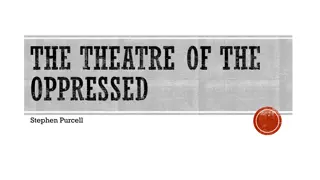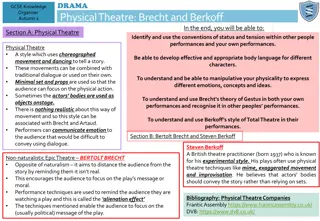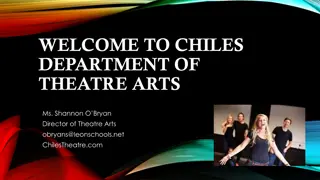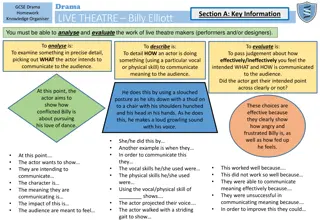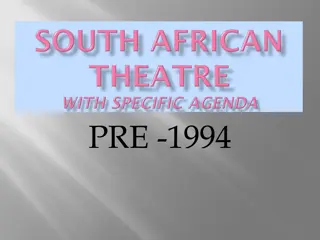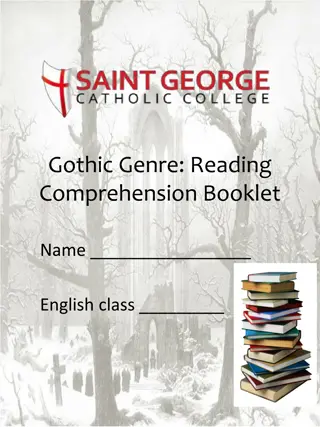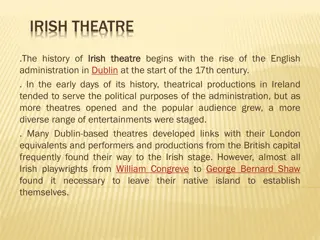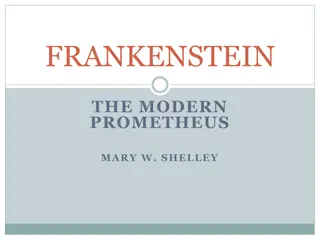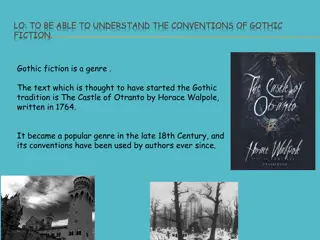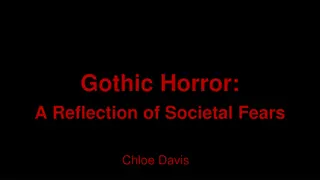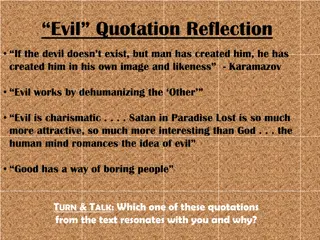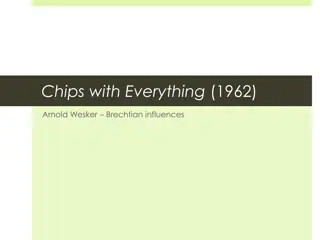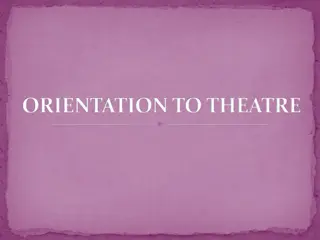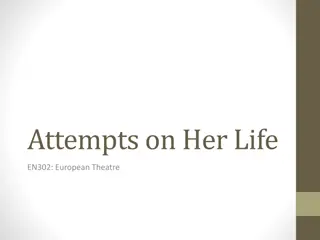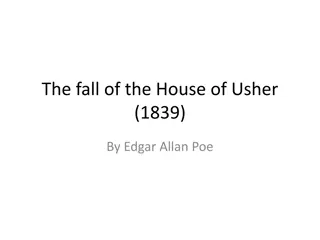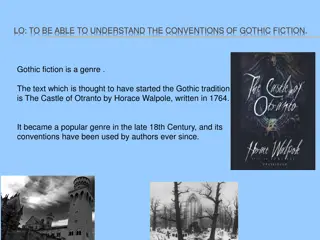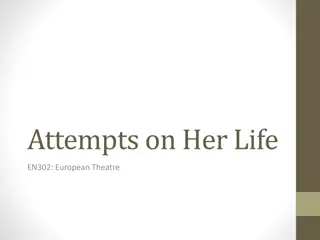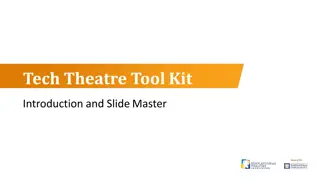Exploring Physical Theatre and Gothic Themes in Teaching Synthesis
Workshop on teaching synthesis through physical theatre and Gothic themes. Learn about synthesising concepts, managing assessments independently, and incorporating subject content in learning. Discover methods for teaching synthesis and enhancing student learning experiences through drama activities and exploration of fairy tales.
Download Presentation

Please find below an Image/Link to download the presentation.
The content on the website is provided AS IS for your information and personal use only. It may not be sold, licensed, or shared on other websites without obtaining consent from the author. Download presentation by click this link. If you encounter any issues during the download, it is possible that the publisher has removed the file from their server.
E N D
Presentation Transcript
Synthesisers: Not Just a 1980s Instrument Tricia Astley Clark-Fookes & Linda Roxette Statham Presenters: LIMITLESS 2015 Drama Queensland Conference
HOW DO YOU TEACH SYNTHESIS? Or more importantly HOW DO STUDENTS LEARN TO SYNTHESISE? We are what we repeatedly do. Excellence , then , is not an act but a habit. Aristotle
What is the aim of this workshop? To explore teaching the concept of synthesis through the content of our subject, the learning that takes place and the management of independent assessment.
Introducing the unit. Hansel & Gretel through Physical Theatre In a Gothic context
Unit Overview Weeks 1&2 That was my mistake (Split Enz) Unit Title: Length:9 weeks Unit FOCUS:Physical Theatre & Gothic Learning experiences 2 weeks- Looked at the themes/iss ues Read the fairytale Games that looked at isolation/control/entrapment Process drama that explores newspaper articles about kids being lost and abandoned Isolation process drama-multi- media to indicate changes in landscapes. Generally Unpacked themes from the fairy tale Hoods (Angela Betzien)-text and physical characterisation of multiple roles The Girl who Cried Wolf(Angela Betzien) haunting lost child beginning. Excerpts of the exchanges between the girls. Read the fairytale/re-tell it through freeze frames/using fabric as a symbol/use a chorus
Weeks 3 and 4 2 weeks on physical theatre Suzuki exercises 7 stages/levels of energy Stomping Freeing the creative impulse (gridwork) Tableaux and ensemble skills Notes on physical Theatre conventions Shape/Architecture and the technology of light Into the school grounds to explore labyrinth to resemble Theseus and the minotaur as an inter-textual reference Image theatre
Weeks 5 and 6 2 weeks on directing Work with some contextless script status Watch videos online of directors working Read some articles/chats with directors about what directors do . Notes on what a director does. In groups devise some scenes from Hansel and Gretel to share. Group A shared with group B and group B went away to brainstorm how the meaning could be made stronger. Use actual text from the Gothic fairytale for the students to use. The two children had also not been able to sleep for hunger, and had heard what their step-mother had said to their father. Gretel wept bitter tears, and said to Hansel: "Now all is over with us." "Be quiet, Gretel," said Hansel, "do not distress yourself, I will soon find a way to help us." And when the old folks had fallen asleep, he got up, put on his little coat, opened the door below, and crept outside Create a mood of anxiety with your bodies in the space on a variety of levels contrasting pace. Add the use ofsecretive creeping
Getting the band together. In your Rock Bands , brainstorm better learning experiences and lesson plans to enable students to demonstrate Forming criteria. Note: Your group is denoted by the headband colour you have.
News Flash! In the Senior Drama Syllabus (2013), Forming and Responding have the word Synthesis in the criteria right down to a C level. So what exactly is synthesis and how is it taught?
What is Synthesis? Our Senior Drama Syllabus (2013) glossary tells us Synthesise: combine elements (information/ideas/components) into a coherent whole.
Synthesis: Its about drawing conclusions, isn t it? If it s about drawing conclusions how does it fit into Forming?
Blooms Taxonomy Creating Evaluation NOW THEN Evaluating Synthesis Analysing Analysis Applying Application Understanding Comprehension Remembering Knowledge
Forming Tasks in 2013 Syllabus Pitfalls, Problems and Perceptions
Delving deeper into Forming.. What is it about the Conventions of Drama that are problematic in the samples that come to State Panel? Conventions=content? How are conventions of Drama taught? How much time is spent in the delivery and exploration of content? This is how our subject develops higher order thinking, through the articulation and elaboration of the use of this content through practical application particularly (for the purposes of this workshop) through Forming and Responding.
Orders of Synthesis in Drama Students integrate the Dramatic Languages making complex relationships between the dramatic languages, explicitly demonstrating their connection to Dramatic Meaning and/or Purpose 1 long sentence overloaded with mentions of the 3 dramatic languages is NOT synthesis Describing the concept of one of the elements/ conventions/ skills Students make clear connections across the Dramatic Languages linking to impact of dramatic choices, dramatic purpose and/or meaning. Identifying the elements of drama present in a piece of dramatic action. Lists of : Conventions, elements Or skills of drama (especially if it s all in one sentence) Students make connections (often causal relationships) between more than one element/skill or convention in one of the Dramatic Languages to derive some dramatic meaning/ purpose.
What does this look like in a Forming task? Synthesis is about creation and the more complex the interplay between the dramatic languages, dramatic meaning and purpose is, then the more insightful and skilful the work.
perceptive and skilful management of elements of drama to create dramatic action skilful management of elements of drama to create dramatic action management of elements of drama to create dramatic action partial management of aspects of elements of drama to make dramatic action Partial use of aspects of elements of drama to make dramatic action perceptive and skilful use of a range of conventions of forms and styles, and skills of drama to shape dramatic action skilful use of a range of conventions of forms and styles, and skills of drama to shape dramatic action use of a range of conventions of forms and styles, and skills of drama to shape dramatic action partial use of conventions of forms and styles, and skills of drama to make dramatic action partial use of aspects of conventions of forms and styles, and skills of drama to make dramatic action Forming Insightful and skilful synthesis of the dramatic languages, purposes and contexts to create dramatic action and meaning. skilful synthesis of the dramatic languages, purposes and contexts to create dramatic action and meaning Synthesis of the dramatic languages, purposes and contexts to create dramatic action and meaning. Partial use of purposes and contexts to make dramatic action and superficial meaning. Partial use of aspects of purposes and contexts to make dramatic action.
What does it look like in a Responding Task? The creation aspect of synthesis in the Responding dimension refers to the position that is articulated about the dramatic action. That is; the more discerning the connections that are made by the students in relation to the dramatic action and meaning, the stronger the quality of the response.
2013 SENIOR DRAMA SYLLABUS FORMING EXIT CRITERIA partial analysis of use of the dramatic languages in dramatic action and meaning discriminating analysis of use of the dramatic languages to facilitate dramatic action and meaning informed analysis of use of the dramatic languages to facilitate dramatic action and meaning analysis of use of the dramatic languages to facilitate dramatic action and meaning explanation of aspects of the dramatic languages used in dramatic action partial evaluation with evidence of how dramatic action communicates aspects of meaning to audiences perceptive and thorough evaluation with discriminating supporting evidence of effectiveness of the dramatic action in communicating meaning to audiences informed evaluation with convincing supporting evidence of effectiveness of the dramatic action in communicating meaning to audiences evaluation with supporting evidence of effectiveness of the dramatic action in communicating meaning to audiences explanation of aspects of the dramatic action Responding communication of positions about aspects of dramatic action and meaning through use of basic language conventions and drama terminology. communication of opinions using basic language conventions. discerning synthesis of positions about dramatic action and meaning through use of relevant language conventions and drama terminology. effective synthesis of positions about dramatic action and meaning through use of relevant language conventions and drama terminology. synthesis of positions about dramatic action and meaning through use of language conventions and drama terminology.
Introducing The synthesiser A Tool for Planning
CONNECT & SYNTHESISE THE DRAMATIC LANGUAGES Which skills of drama will I select and connect with an element or convention to demonstrate to the students how meaning has been enhanced Which element of drama will I focus on to work with a skill or convention to better allow the students to make the connection? Which Lesson Key Learning Ideas Resources convention will I focus on in order to explain how this creates meaning with skills and/or elements?
Getting the band back together. In your Rock Bands , brainstorm key learning experiences using The Synthesiser . Your group will allocated a style to work with. Note: Your group is denoted by the headband colour you have.
Pearls of wisdom ..a bit of an indulgence really but humour us we re nice!
Hot 4 Tips Do yourself a favour 1. Don t let the Sun go down on conventions (Elton John) 2. What about Me: Synthesis (Moving Pictures) 3. Don t you Forget about Me : Synthesising always was in the Forming dimension/objective but now it appears in the exit criteria .. 4. Orinoco Flow a much misunderstood song. We interviewed Enya The term Orinoco apparently means the linking of content in the form of the full breadth of the dramatic languages overtly addressed and the term Flow refers to the development of higher order thinking, through the articulation and elaboration of the use of this content.


